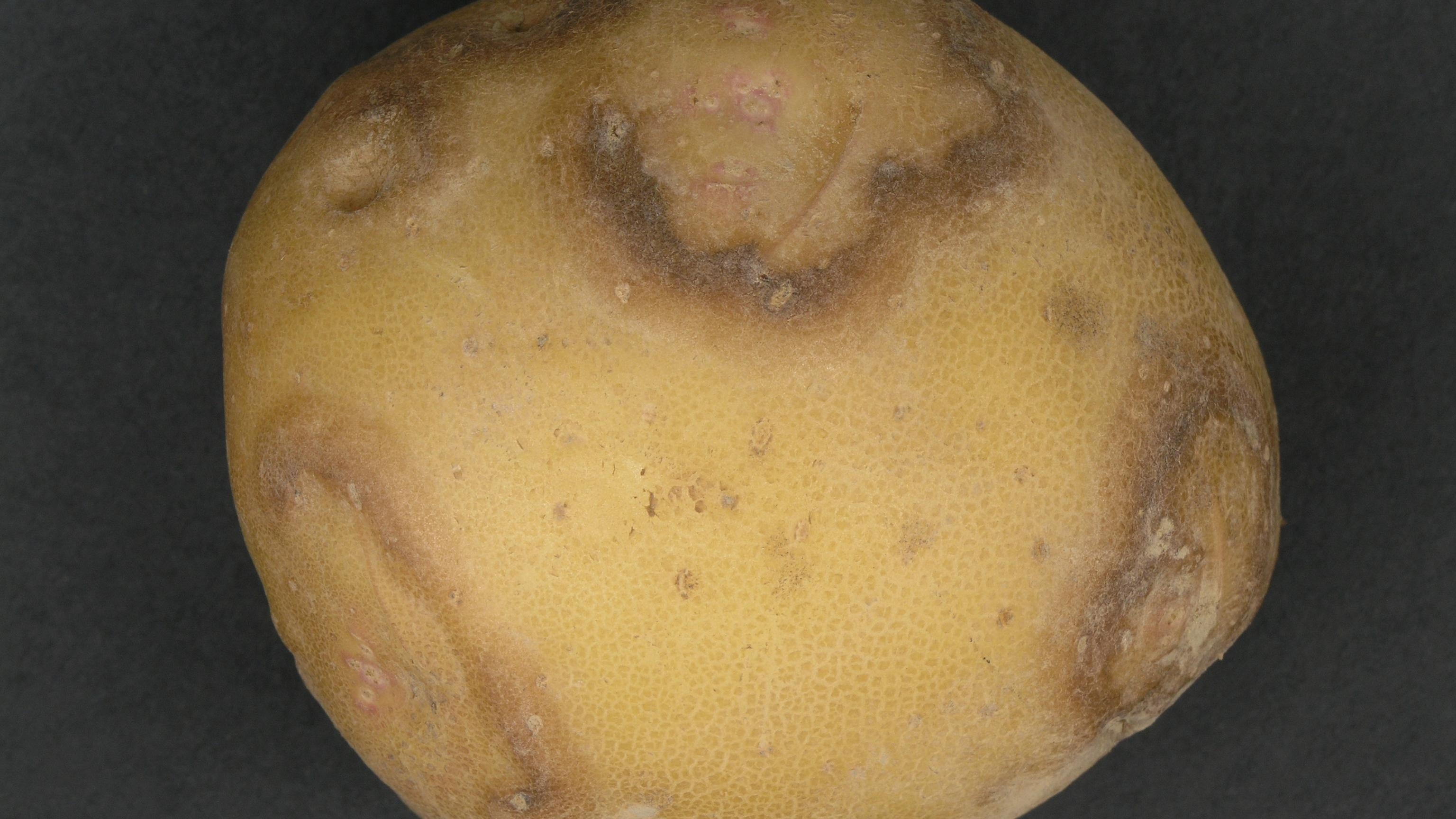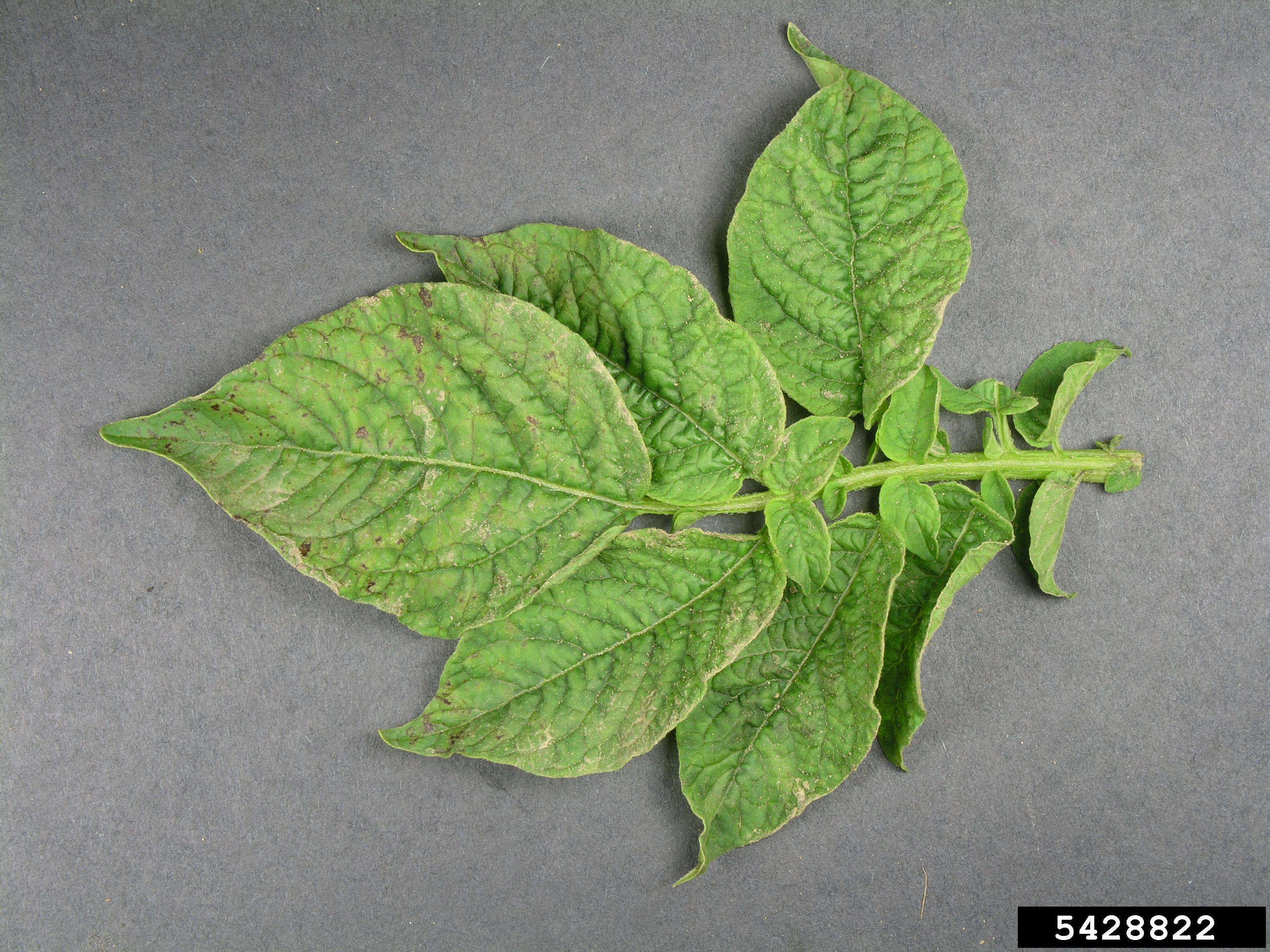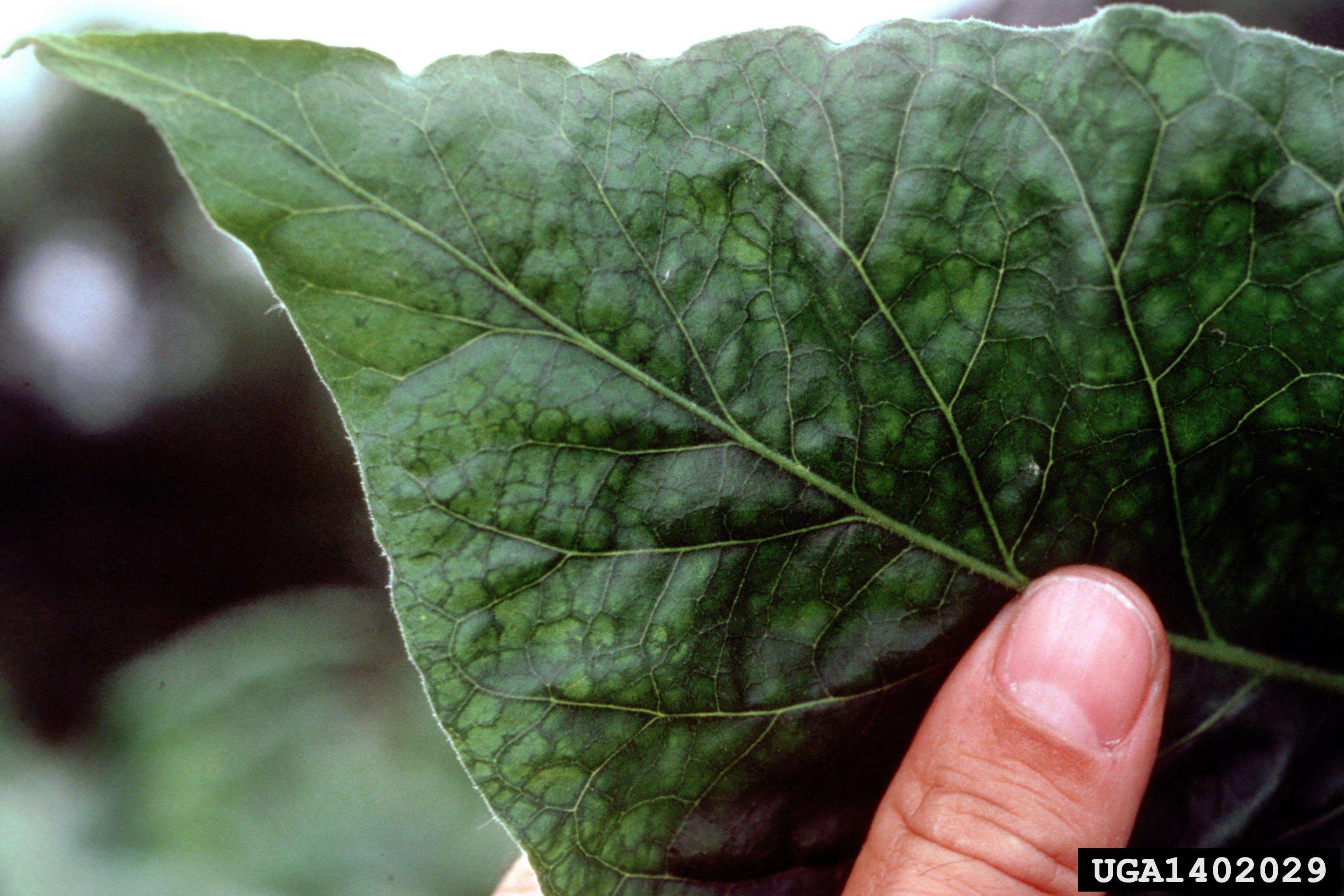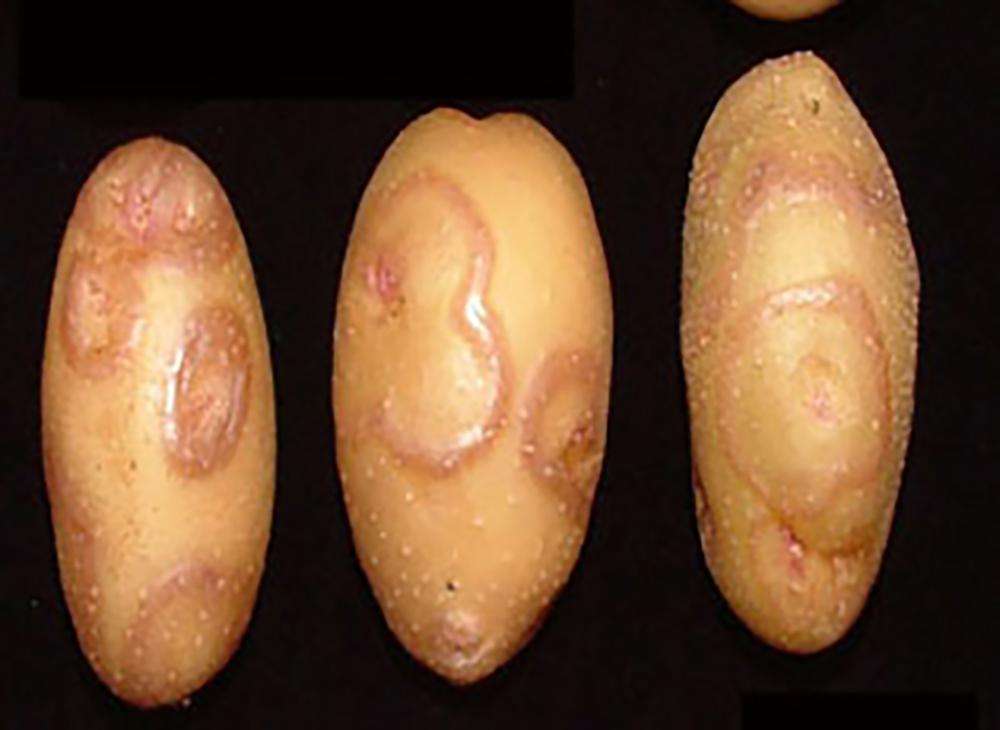Potato Virus Y

Photo credit: Bruce Watt, University of Maine, Bugwood.org
Potato virus Y (PVY) complex causes disease in many types of plants and crops including potato, tomato, pepper, tobacco, and eggplant. Symptoms range from mild yellow mottling on leaves to tuber necrosis (dying cells), which eventually kills the plant. Some plants don't show any symptoms, which makes it difficult for seed growers to remove diseased plants and leaves whole fields vulnerable to infection. PVY does not harm people or animals.
PVY is widespread in Europe and has been present in Canada and the United States for decades. There are three strains: a common strain (PVYO) and two necrotic strains (PVYN and PVYNTN). The necrotic strains pose a significant threat to the U.S. potato industry and seed trade. APHIS classifies all PVY strains as nonquarantine regulated pests.
Symptoms vary depending on the strain, the plant variety, and environmental conditions.
- The common strain, PVYO, causes a mosaic pattern in the leaves of infected plants.
- This appears as a green and yellow variation (yellow flecking) but can also show up as a roughness in the leaves.
- PVYO reduces yield but doesn't affect tubers (thick, fleshy part of the stem that grows underground).
- The necrotic strains (PVYN and PVYNTN) affect tuber quality in a way that is hard to remedy.
- On potato crops, look for raised rings of darker brown or reddened skin around the tuber eyes. This damage may also extend into the tuber flesh.
- On tobacco, you may see a veinal necrosis (when a plant's veins turn a dark color, usually brown or black).
- PVY Complex
- PVY occurs as a complex of virus strains, some of which can be distinguished by reactions on tobacco and potato cultivars and by various laboratory diagnostic assays. Recognized strains covered by the Canada/U.S. Management Plan for Potato Viruses That Cause Tuber Necrosis (42.44 KB) include, but are not limited to, those described in the Definitions and Description Section of the management plan.
| PVY Strain | Foliar Symptoms–Tobacco1 | Foliar Symptoms–Potato2 | Tuber Symptoms–Potato3 | Serological Reaction4 |
|---|---|---|---|---|
| PVYO | Mild mosaic | Severe mosaic Vein necrosis Leaf drop | No symptoms3 | 4C3 – pos MAb2 – pos 1F5 – neg SASA N – neg |
| PVYO5 | Mild mosaic | Severe mosaic Vein necrosis Leaf drop | No symptoms3 | 4C3 – pos MAb2 – pos 1F5 – pos SASA N – neg |
| PVYN | Vein necrosis | Mild mosaic | No symptoms3 | 4C3 – pos MAb2 – neg 1F5 – pos SASA N – pos |
| PVYNTN | Vein necrosis | Mild mosaic | Tuber necrosis | 4C3 – pos MAb2 – neg 1F5 – pos SASA N – pos |
| PVYNE11 | Vein necrosis Mild mosaic | Mild mosaic | Tuber necrosis | 4C3 – pos MAb2 – neg 1F5 – pos SASA N – pos |
| PVYE | Mosaic | Mild mosaic | Tuber necrosis | 4C3 – pos MAb2 – neg 1F5 – pos SASA N – pos |
| PVYN-Wi (N:O) | Vein necrosis | Mild mosaic | No symptoms3 | 4C3 – pos MAb2 – pos 1F5 – neg SASA N – neg |
1. These are typical symptoms for most virus isolates belonging to the strain, but exceptions have been noted.
2. These are common symptoms, but symptom type and severity will vary among cultivars and among virus isolates within each strain.
3. While most isolates of PVYNTN, PVYNE11, and PVYE induce some degree of potato tuber necrotic ringspot disease, a limited number of virus isolates from any strain can induce tuber necrosis symptoms in some potato cultivars.
4. ELISA using monoclonal antibodies 4C3, Mab2, and 1F5 originally described by Ellis et al. and commercially available from Agdia, Inc. and Science & Advice for Scottish Agriculture, Edinburgh, Scotland.
In general, the necrotic strains tend to cause a milder mosaic symptom than PVYO in potato.



PVY symptoms on potato plant leaves. Bruce Watt, University of Maine, Bugwood.org
PVY symptoms on a tobacco leaf. R.J. Reynolds Tobacco Company, Bugwood.org
Raised rings of darker brown or reddened skin around potato tuber eyes. This damage may also extend into the tuber flesh. P.M. Baldauf, S.M. Gray, and K.L. Perry, Department of Plant Pathology, Cornell University and USDA Agricultural Research Service
PVY spreads naturally by aphids and sap-sucking insects. It can also spread to plants on contaminated tools or equipment or by touching healthy plants after handling infected plants. This type of disease spread is difficult to prevent. Insecticides may help to reduce aphid populations, but these treatments will not kill all virus-carrying aphids and transmission of the virus will continue.
Using certified seed potatoes that are low in virus levels is the best method available to control PVY strains in the potato industry. Knowing which plant varieties are susceptible and how symptoms appear in the varieties you grow is also important.
There is no cure for PVY-infested host plants. Once a plant is infected, it stays infected for life and the virus can spread through the mother plant to tubers produced by the mother plant. The best defense against PVY is to use high-quality certified seed and to follow best management practices.
Virus Management Methods
In-Vitro Material
- All plants in a tissue culture bank or introduced into tissue culture must be tested with an ELISA that uses antibodies known to react with all PVY strains. All plants must be found free of PVY.
Protected Environment (greenhouse, screenhouse, or growth chamber)
- Seed potato production in a protected environment will be tested at least annually for PVY.
- Any crop or lot grown in a protected environment that tests positive for PVY must be destroyed if it is found to be PVYNTN; it can be downgraded if found to be infected with another strain of PVY.
- If aphid vectors are detected in the protected environment when the crop is growing, testing must be conducted to determine freedom from PVY.
Field-Grown Seed
- All seed transported across State boundaries must be certified by the State in order to be entered into the certification process or sold as seed for use in commercial production.
Report Plant Pests and Diseases
Have you seen this pest or signs of pest damage? Immediately report your findings. If your State has a seed certification agency, please report your findings to that agency as well.
Find your State plant regulatory official
Find your State plant health director
Controlling Potato Virus Y
PVY is a nonquarantine regulated pest in the United States.
The necrotic strain PVYN was first reported in Canada in the 1990s and in the Pacific Northwest of the United States in 2002. It then spread to other regions of the United States and several Canadian provinces.
After the first report of PVYN in Canada in the early 1990s, the United States and Canada implemented a PVYN Management Plan. We later revised and expanded the plan to include other emerging viruses that can cause tuber necrosis in potato. The Canada/U.S. Management Plan for Potato Viruses That Cause Tuber Necrosis (42.44 KB) includes management methods for PVY, potato mop top virus, and tobacco rattle virus.
The plan helps to facilitate the trade of potatoes within and between the United States and Canada while protecting the potato industry from these viruses. We work with industry on an annual basis to review and refine management strategies and research needs listed in the plan.
All field-grown potato seed transported across State boundaries must be State-certified in order to be entered into the certification process or sold as seed for use in commercial production. For more information, contact your State potato seed certification agency.
Testing
Detection and diagnosis of PVY strains is difficult. Currently, there isn't one method that separates all strains into their respective types. Serology can distinguish between PVYO and PVYN but doesn't separate N from NTN strains.
A tobacco bioassay remains the best method to identify necrotic isolates. However, to confirm NTN, this test requires a tuber grow out on sensitive potato cultivars under standard conditions. (Environment and cultivar may affect the development of tuber necrotic symptoms.)
Finally, many primer sets have been developed for use in RT-PCR tests, but they may not detect all possible strains.




